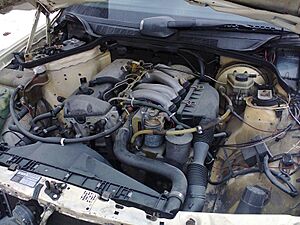Naturally aspirated engine facts for kids
A naturally aspirated engine is a type of internal combustion engine. This means it's an engine that burns fuel inside itself to create power. What makes it "naturally aspirated" is how it gets its air. It simply breathes in air from the atmosphere around it. It doesn't use special devices like a turbocharger or a supercharger to push more air in.
Many sports cars use naturally aspirated engines. This is because they don't have "turbo lag." Turbo lag is a slight delay you might feel when a turbocharged engine starts to speed up. A big plus for naturally aspirated engines is that they are often more reliable. They have fewer complex parts than engines with turbos or superchargers.
Most gasoline engines in cars are naturally aspirated. Many smaller engines, like those in lawnmowers or generators, also work this way. However, most modern diesel engines in trucks and buses use turbochargers. This helps them make more power for their size. It also makes them use less fuel and produce fewer exhaust emissions.
Contents
How Naturally Aspirated Engines Work
Naturally aspirated engines work by creating a vacuum inside their cylinders. Think of it like a syringe pulling in air. When the piston moves down, it creates a low-pressure area. The higher pressure outside the engine then pushes air into the combustion chamber. This air mixes with fuel, and then the mixture is ignited to create power.
The Air Intake Process
The air intake process is simple and direct. Air flows from the outside, through an air filter, and then into the engine's intake manifold. From there, it goes into the cylinders. There are no fans or compressors forcing the air in. The engine relies completely on the difference in air pressure.
Advantages of Naturally Aspirated Engines
Naturally aspirated engines have several good points. They are often simpler in design, which can make them more dependable.
Reliability and Maintenance
Because these engines have fewer parts, there's less that can go wrong. This often means they are more reliable. They can also be easier and cheaper to maintain. There are no complex turbochargers or superchargers to worry about.
Engine Response and Sound
Many drivers like the way naturally aspirated engines respond. They offer a very direct connection between pressing the gas pedal and the engine speeding up. This is because there's no turbo lag. Also, some people prefer the sound of a naturally aspirated engine. They often have a smoother, more natural engine note.
Disadvantages of Naturally Aspirated Engines
While naturally aspirated engines have benefits, they also have some drawbacks compared to forced induction engines.
Power Output and Efficiency
Naturally aspirated engines usually make less power for their size. This is because they can't pack as much air into the cylinders as a turbocharged engine. More air means more fuel can be burned, which creates more power. They also might not be as fuel-efficient as some modern turbocharged engines.
Performance at High Altitudes
At high altitudes, the air is thinner. This means there's less oxygen available for the engine to breathe in. Naturally aspirated engines can lose a lot of power in these conditions. Turbocharged engines, however, can often make up for the thinner air by forcing more of it into the engine.
Images for kids
-
Typical airflow in a four-stroke engine: In stroke #1, the pistons suck in (aspirate) air to the combustion chamber through the opened inlet valve.
See also
 In Spanish: Motor atmosférico para niños
In Spanish: Motor atmosférico para niños



